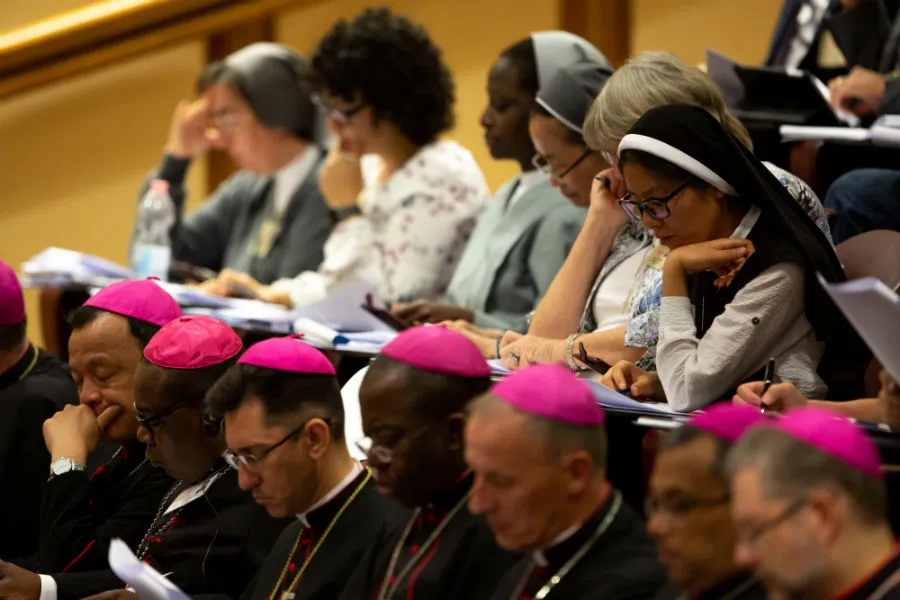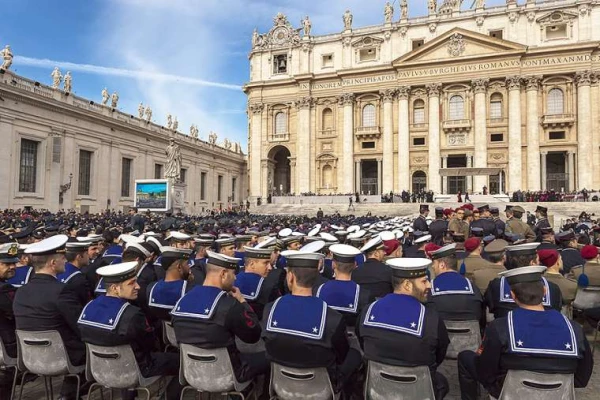
Vatican City, Oct 27, 2018 / 05:05 pm (CNA).- The final document of the Synod of Bishop’s fifteenth general session was approved by the members and released late Saturday. While the session was convened to discuss the topics of young people, the faith, and vocational discernment, the concept of “synodality” itself emerged as a key subject in the final text.
In the past, Pope Francis has spoken of synodality as a “constitutive dimension” of the Church, though the meaning of the term has been open to broad and narrow interpretations. The synod’s final document repeated the pope’s words but, while calling for the Church to become more synodal at all levels, it offered more description than definition.
The document was approved by paragraph-by-paragraph vote of the synod members Oct. 27, with a two-thirds majority needed to adopt a passage into the final text.
The third section of the document, headed “They set out at once,” aligns the concept of synodality with the Church’s universal character and constitution as the Mystical Body of Christ.
“Synodality characterizes both the life and the mission of the Church, which is the People of God formed of young and old, men and women of every culture and horizon, and the Body of Christ, in which we are members of each other, starting from those who are marginalized and downtrodden,’ the document reads.
The text says that one of the results of the synod sessions has been emergence of “some fundamental features of a synodal style” which the wider Church is called to adopt.
This new “style” is presented as a Church defined by relationships.
“The Church is called to assume a relational face that focuses on listening, welcoming, dialogue, and common discernment in a process that transforms the lives of those who participate in it.” It is through relationships characterized like this, the document says, that the faith is transmitted.
The final document speaks of the Church as a venue for dialogue and collaboration between the pope, the bishops, and the faithful, and underscores the diversity of charisms within it. The goal of synodality is “to move towards a participatory and co-responsible Church capable of enhancing the richness of the variety of which it is composed.”
The synod document specifically calls for the inclusion of young people in positions of “co-responsibility” at all levels of the Church, including in dioceses, at the level of bishops’ conferences, and the universal Church. How exactly a “participatory and co-responsible Church” functions is not defined at each level, though there is a specific call for the Dicastery for Laity, Family, and Life to establish a international representative body.
The common experience of “walking together” as a synodal Church is presented as a remedy for clericalism, which some bishops have blamed for different problems in the Church, including the sexual abuse crises which have erupted in different parts of the world in recent months.
The document stresses that in valuing the unique contributions of lay men and women, including religious brothers and sisters, “no one must be put aside.” This, the synod document proposes, “is the way to avoid clericalism, which excludes many from the decision making process,” and also prevents the “clericalization of the laity” which diverts them away from their missionary role in the wider world.
The document’s discussion of synodality suggests that, properly deployed, it increases the understanding of “authority in terms of service.” The report calls on pastors to increase their collaborative efforts at every level of the Church “to accompany processes of community discernment to interpret the signs of the times in the light of faith and under the guidance of the Spirit, with the contribution of all the members of the community.”
The report also advances the recommendation of “common training” for young lay people, young religious and seminarians, “in particular as regards issues such as the exercise of authority or working as a team.”
If you value the news and views Catholic World Report provides, please consider donating to support our efforts. Your contribution will help us continue to make CWR available to all readers worldwide for free, without a subscription. Thank you for your generosity!
Click here for more information on donating to CWR. Click here to sign up for our newsletter.




““Synodality characterizes both the life and the mission of the Church, which is the People of God formed of young and old, men and women of every culture and horizon, and the Body of Christ, in which we are members of each other, starting from those who are marginalized and downtrodden,’ the document reads.”
Gosh, why does the phrase “mealymouthed claptrap” keep running thourgh my mind?
““Synodality characterizes both the life and the mission of the Church, which is the People of God formed of young and old, men and women of every culture and horizon, and the Body of Christ, in which we are members of each other, starting from those who are marginalized and downtrodden,’ the document reads.”
Communion could be used in this sentence instead of synodality, and I don’t think the meaning would be affected too much. So why exactly do they mean by synodality?
Before talking about synodality they should be talking about reforming the episcopal office within the Patriarchate of Rome. All this talk about the role of bishops in Vatican 2 and now they have the concept of “synodality” and yet has anything really changed in how bishops pastor or fail to pastor their churches?
The CNA article reports that, “How exactly a ‘participatory and co-responsible Church’ functions is not defined at each level, though there is a specific call for the Dicastery for Laity, Family, and Life to establish an international representative body.” In response, three points:
1. Can we be confident that the dicastery will be sufficiently reflective to engage Pope St. John Paul II who, in Christifideles Laici (CL, the Vocation of the Laity, 1988), already mercifully explores answers to this question of functioning—at more than one (reductionist?) level?
The 2018 synod’s wise warning against “clericalization of the laity” is wording from JP II, and probably CL, and is paired with a warning against the “laicization of the clergy” (i.e., presuming overly-detailed competence and responsibility in the secular realm).
2. Synodality in practice is also reminded in CL that,
“the ordained ministries apart from the persons who receive them, are a grace for the entire Church. These ministries express and realize a participation in the priesthood of Jesus Christ that is different, not simply in degree but in essence [!], from the participation given to all the lay faithful through Baptism and Confirmation” (n. 22, citing Lumen Gentium, 10).
Will such clarity of sacramental roles be affirmed and consistently respected, or not? (Recent silences toward Veritatis Splendor give cause for wondering…) Likewise, regarding Church responses to secular/global urgencies raised by the youth in their “compass paper” of last March–and for whom “the lay state of life has its distinctive feature in its secular character” (CL, n. 55)?
3. One more timely relevance of CL (among many more) is this overall way of framing the earlier and ongoing challenge (from n. 2):
“At the same time, the synod [1987] has pointed out that the post-conciliar path of the lay faithful has not been without its difficulties and dangers. In particular, two temptations can be cited which they have not always known how to avoid: [1] the temptation of being so strongly interested in Church services and tasks that some fail to become actively engaged in their responsibilities in the professional, social, cultural and political world; [2] and the temptation of legitimizing the unwarranted separation of faith from life, that is, a separation of the Gospel’s acceptance from the actual living of the Gospel in various situations in the world” [not helped today by a false dichotomy between “abstract” (sic moral) truths and “concrete” cases, or by any paradigm discounting of the interior life].
So, following the 1988 and 2018 synods the Church has increased hope for well-grounded creativity as we get on with the New Evangelization.
So basically more heterodox swill was approved via committee that violates perennial Catholic teaching, and will be used to further protestantize the Church and bulldoze it into the ground.